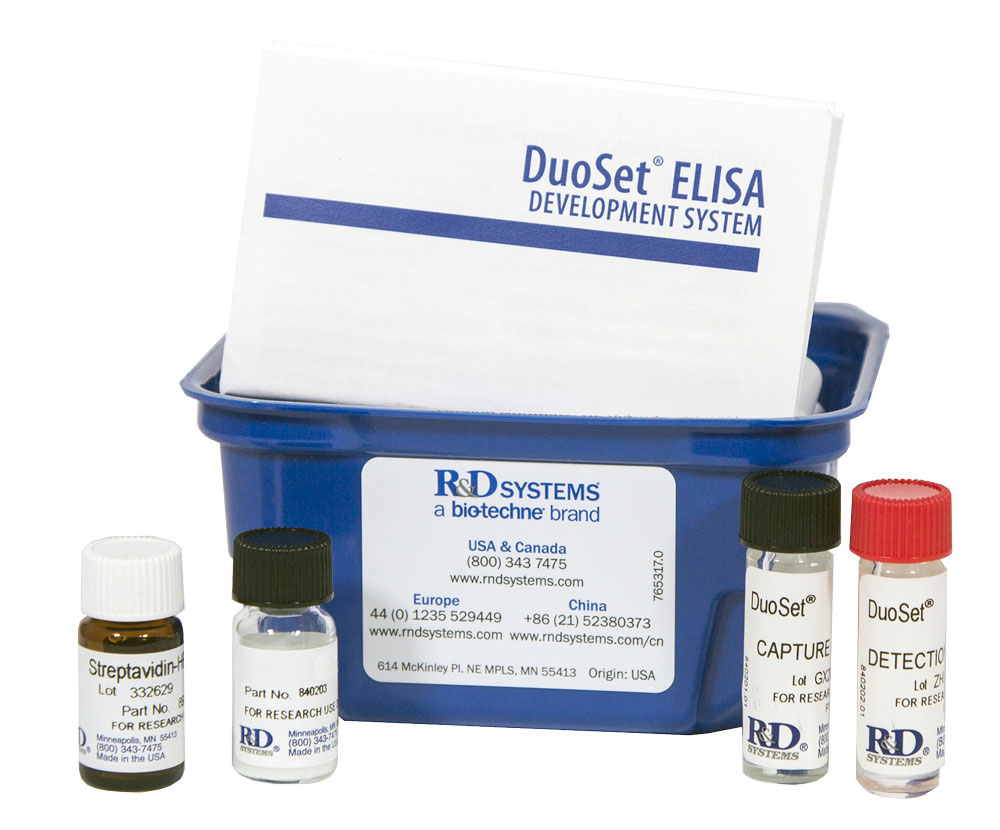Human Irisin/FNDC5 DuoSet ELISA Summary
* Provided that the recommended microplates, buffers, diluents, substrates and solutions are used, and the assay is run as summarized in the Assay Procedure provided.
Product Features
- Optimized capture and detection antibody pairings with recommended concentrations save lengthy development time
- Development protocols are provided to guide further assay optimization
- Assay can be customized to your specific needs
- Economical alternative to complete kits
Kit Content
- Capture Antibody
- Detection Antibody
- Recombinant Standard
- Streptavidin conjugated to horseradish-peroxidase (Streptavidin-HRP)
Other Reagents Required
The components listed above may be purchased separately:
PBS: (Catalog # DY006), or 137 mM NaCl, 2.7 mM KCl, 8.1 mM Na2HPO4, 1.5 mM KH2PO4, pH 7.2 - 7.4, 0.2 µm filtered
Wash Buffer: (Catalog # WA126), or 0.05% Tween® 20 in PBS, pH 7.2-7.4
Reagent Diluent: (Catalog # DY995), or 1% BSA in PBS, pH 7.2-7.4, 0.2 µm filtered
Substrate Solution: 1:1 mixture of Color Reagent A (H2O2) and Color Reagent B (Tetramethylbenzidine) (Catalog # DY999)
Stop Solution: 2 N H2SO4 (Catalog # DY994)
Microplates: R&D Systems (Catalog # DY990)
Plate Sealers: ELISA Plate Sealers (Catalog # DY992)
Product Datasheets
Preparation and Storage
Assay Procedure
GENERAL ELISA PROTOCOL
Plate Preparation
- Dilute the Capture Antibody to the working concentration in PBS without carrier protein. Immediately coat a 96-well microplate with 100 μL per well of the diluted Capture Antibody. Seal the plate and incubate overnight at room temperature.
- Aspirate each well and wash with Wash Buffer, repeating the process two times for a total of three washes. Wash by filling each well with Wash Buffer (400 μL) using a squirt bottle, manifold dispenser, or autowasher. Complete removal of liquid at each step is essential for good performance. After the last wash, remove any remaining Wash Buffer by aspirating or by inverting the plate and blotting it against clean paper towels.
- Block plates by adding 300 μL Reagent Diluent to each well. Incubate at room temperature for a minimum of 1 hour.
- Repeat the aspiration/wash as in step 2. The plates are now ready for sample addition.
Assay Procedure
- Add 100 μL of sample or standards in Reagent Diluent, or an appropriate diluent, per well. Cover with an adhesive strip and incubate 2 hours at room temperature.
- Repeat the aspiration/wash as in step 2 of Plate Preparation.
- Add 100 μL of the Detection Antibody, diluted in Reagent Diluent, to each well. Cover with a new adhesive strip and incubate 2 hours at room temperature.
- Repeat the aspiration/wash as in step 2 of Plate Preparation.
- Add 100 μL of the working dilution of Streptavidin-HRP to each well. Cover the plate and incubate for 20 minutes at room temperature. Avoid placing the plate in direct light.
- Repeat the aspiration/wash as in step 2.
- Add 100 μL of Substrate Solution to each well. Incubate for 20 minutes at room temperature. Avoid placing the plate in direct light.
- Add 50 μL of Stop Solution to each well. Gently tap the plate to ensure thorough mixing.
- Determine the optical density of each well immediately, using a microplate reader set to 450 nm. If wavelength correction is available, set to 540 nm or 570 nm. If wavelength correction is not available, subtract readings at 540 nm or 570 nm from the readings at 450 nm. This subtraction will correct for optical imperfections in the plate. Readings made directly at 450 nm without correction may be higher and less accurate.
Citations for Human Irisin/FNDC5 DuoSet ELISA
R&D Systems personnel manually curate a database that contains references using R&D Systems products. The data collected includes not only links to publications in PubMed, but also provides information about sample types, species, and experimental conditions.
4
Citations: Showing 1 - 4
Filter your results:
Filter by:
-
Maresin 1 Exerts a Tissue-Specific Regulation of Adipo-Hepato-Myokines in Diet-Induced Obese Mice and Modulates Adipokine Expression in Cultured Human Adipocytes in Basal and Inflammatory Conditions
Authors: Martínez-Fernández, L;Burgos, M;Sáinz, N;Laiglesia, LM;Arbones-Mainar, JM;González-Muniesa, P;Moreno-Aliaga, MJ;
Biomolecules
Species: Human
Sample Types: Cell Culture Supernates
-
The serum irisin response to prolonged physical activity in temperate and hot environments in older men with hypertension or type 2 diabetes
Authors: JJ McCormick, KE King, SR Notley, N Fujii, P Boulay, RJ Sigal, T Amano, GP Kenny
Journal of thermal biology, 2022-09-24;110(0):103344.
Species: Human
Sample Types: Serum
-
Exercise in the heat induces similar elevations in serum irisin in young and older men despite lower resting irisin concentrations in older adults
Authors: JJ McCormick, KE King, SR Notley, N Fujii, P Boulay, RJ Sigal, GP Kenny
Journal of thermal biology, 2022-01-15;104(0):103189.
Species: Human
Sample Types: Serum
-
Exercise-Induced Irisin Decreases Inflammation and Improves NAFLD by Competitive Binding with MD2
Authors: W Zhu, NE Sahar, HMA Javaid, ES Pak, G Liang, Y Wang, H Ha, JY Huh
Cells, 2021-11-25;10(12):.
Species: Mouse
Sample Types: Tissue Homogenates
FAQs
No product specific FAQs exist for this product, however you may
View all ELISA FAQsReviews for Human Irisin/FNDC5 DuoSet ELISA
Average Rating: 4 (Based on 1 Review)
Have you used Human Irisin/FNDC5 DuoSet ELISA?
Submit a review and receive an Amazon gift card.
$25/€18/£15/$25CAN/¥75 Yuan/¥2500 Yen for a review with an image
$10/€7/£6/$10 CAD/¥70 Yuan/¥1110 Yen for a review without an image
Filter by:
A bit of an struggle to get this working, we got good standard curves but signal for actual samples is lower than expected so it needs a bit of working out. Plasma needs to be used neat and washes increased to bring the blank signal down.


